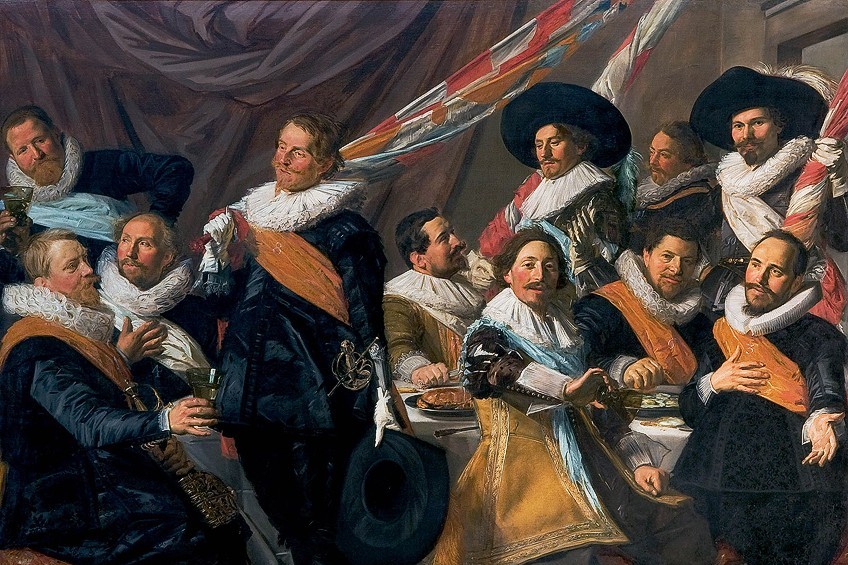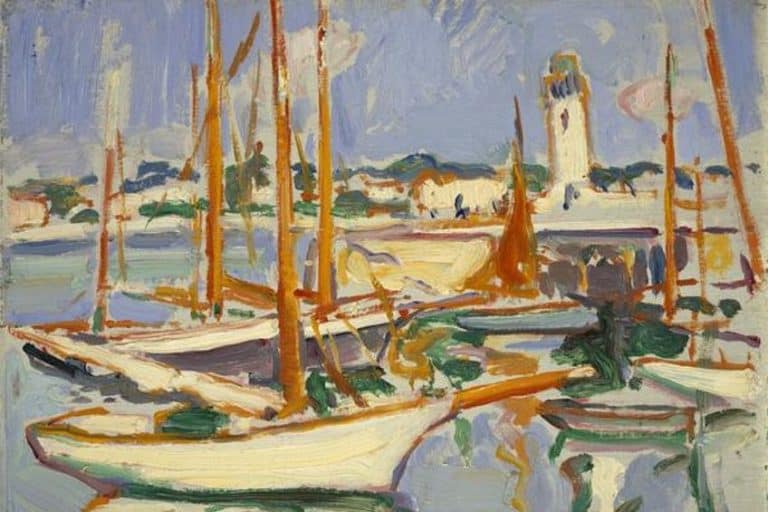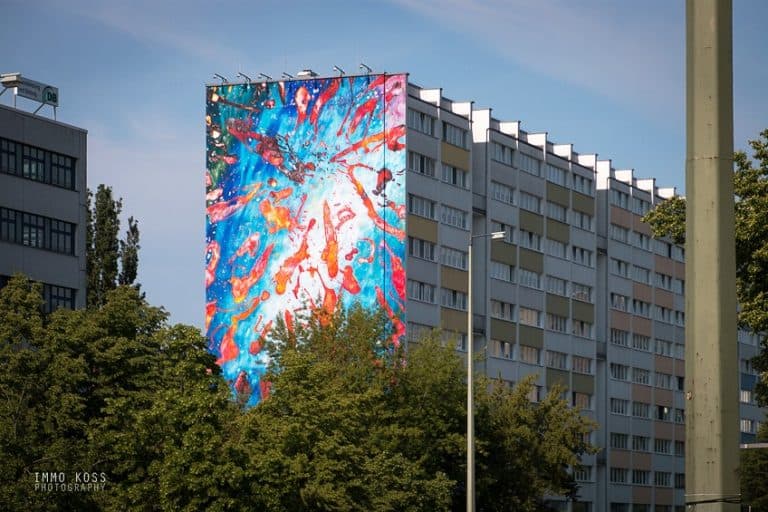Frans Hals – Discover the Life and Artworks of This Dutch Painter
Dutch painter Frans Hals was the very first Master of the Golden Age of painting in Holland, and his artistic energy and vivid character representations had a huge part in the formation of portraits as a genre. Rather than complying with contemporaneous conceptions of beauty or cliched portrayals, Frans Hal’s group portraits have evidently distinguished faces that are distinctive and natural-looking in the image, and his subjects are frequently depicted in comfortable poses and circumstances, interacting with those around them rather than peering straight ahead. This attitude to portraiture was novel, and Frans Hals’ paintings inspired numerous imitators during his lifetime, as well as many of his techniques being adopted as part of larger movements in Dutch art.
Frans Hals’ Biography
| Nationality | Dutch |
| Date of Birth | 1582 |
| Date of Death | 26 August 1666 |
| Place of Birth | Antwerp, Flanders |
In the 19th century, Dutch painter Frans Hals’ ideas saw a renaissance, with his works inspiring both the topic and the aesthetic approach of the Impressionists. Many of Frans Hals’ paintings feature a smile, ranging from a gleam in the eye to a big grin, which was rare at a time when sitters were generally shown with their lips closed and a serious look.
Hals managed to depict laughing expertly, and his figures are more dynamic human than those of many of his peers.
Childhood
Frans Hals was born in Antwerp about 1583 to cloth dealer Franchois Fransz Hals van Mechelen and Adraentje von Geertenryck. Frans Hals had two brothers, Joost and Dirck, who were both painters, albeit none of Joost’s works exists now. Even though Hals and his family were Catholics, Dirck was christened in the Protestant religion in Haarlem.

Education and Early Training
Hals studied with Karel van Mander, a notable Mannerism painter and art writer in Haarlem, beginning in 1600. His principles and manner, however, are not substantially represented in Hals’ work. At roughly 28 years old, Hals entered the painter’s guild of St Luke in 1610, which was exceptionally late for somebody becoming a guild member for the first time.
Along with his paintings, he started working for the municipal government as an art restorer. He wedded Anneke Harmensdochter at this period.

Because she was a Protestant and he was Catholic, they married at the municipal hall rather than in a church. Anneke died in 1615, only a few years after. In their brief marriage, they produced three children, only one of whom, Harmen, survived childhood. The accusation that Hals assaulted his wife was debunked by art expert Seymour Slive, who demonstrated that another Haarlem citizen with the same identity was charged with the same offense in 1616. The fact that Anneke died in 1615 lends credence to this.
Mature Period
From 1612 until 1624, Hals worked as a musketeer in Haarlem’s Saint George civic guard, for whom he was requested to create a portrait of the company’s leaders in 1616, his first large-scale, public commission. The same year, he made a rare excursion to Antwerp, where he would have seen paintings by peers such as Peter Paul Rubens and a young Van Dyck.
This interaction may have impacted Hals’ free brushwork and use of blue-green shadow tones since similar artistic elements can be observed in Rubens’ paintings from around this time./strong>
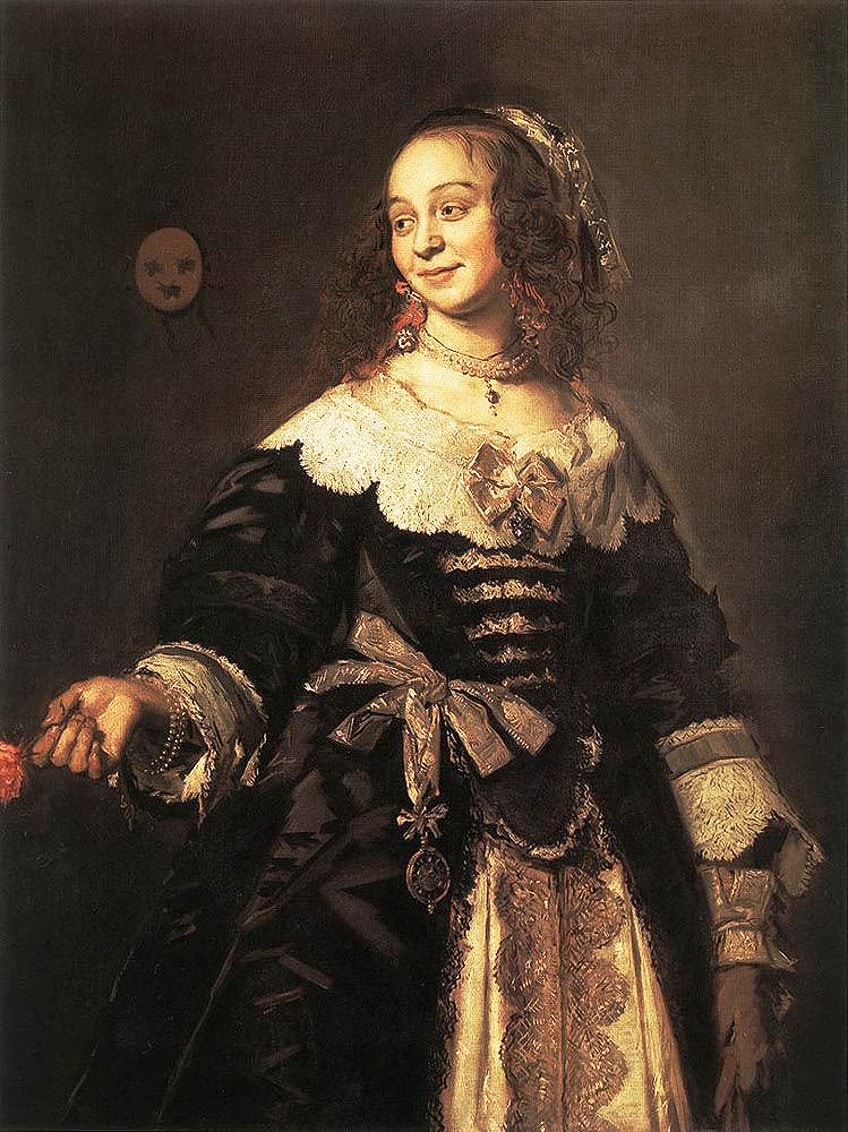
From 1616 through 1624, Hals was a member of The Vine Tendril, a Haarlem rhetoric club. In February 1617, two years after the death of his first wife, Hals married Lysbeth Reyniers in Spaarndam, near Haarlem. Only nine days later, she gave birth to a daughter, and they proceeded to have eight children together. Lysbeth was reprimanded many times by Haarlem officials for brawling, according to municipal archives. He lived the remainder of his life in Haarlem as a recognized but monetarily modest portraitist.
He painted numerous Haarlem residents, including affluent businessmen, politicians, and dignitaries, as well as less fortunate members of the general people.
Late Period
Hals was elected a director of the Guild of St Luke in 1644. His job, however, fell out of favor as he grew older, and he battled to make ends meet and maintain his family. He augmented his income by repairing artworks and providing art tax advice to the municipal government. Nonetheless, he became indebted, and court records reveal that in 1652, he had to auction his possessions to pay off a debt.
He lived in relative poverty in his later years, but he got an annual pension from the town government beginning in 1664, suggesting that he was still a well-respected resident.
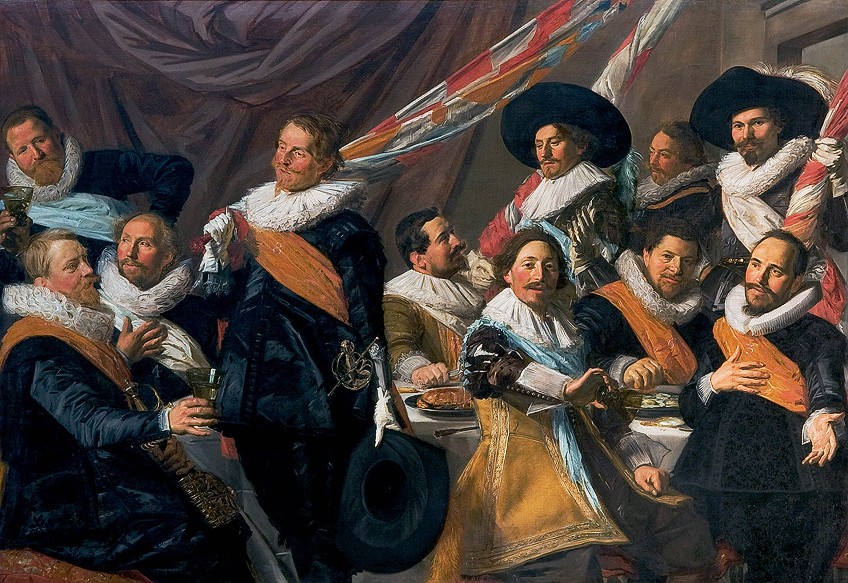
He died in Haarlem and was buried in St Bavo’s Church in 1666. Due to Frans Hals’ financial difficulties and a lack of recorded proof, many people speculated about his life, including the 18th-century biographer Arnold Houbraken, who said he led a debaucherous existence typified by frequent drinking.
This concept was inspired by his genre paintings of happy characters like entertainers and courtiers, as well as his portraiture of breweries.
Nevertheless, as Walter Liedtke argues in his important work Frans Hals: Style and Substance (2011), the latter were among the town’s richest people and would have placed a high priority on having themselves depicted favorably.
Legacy
Hals’ ability to imbue his portraits with a feeling of profound uniqueness and personality, as well as his distinct brushstrokes, influenced a great number of artists, including his brother Dirck and five of his sons, all of whom went on to become painters.
Despite a decline in popularity later in his career and for two centuries after his death, his significance as a breakthrough artist was rediscovered in the second part of the nineteenth century.

His method inspired Courbet, Manet, and Whistler, as well as Max Liebermann and Lovis Corinth. The latter cited Hals as his greatest inspiration, while Liebermann strove to mimic his impulsive and expressive use of paint.
Vincent van Gogh praised Hals as well, noting that he accomplished “the painting of mankind, let us say of an entire republic, using the simple medium of the portrait.”
Frans Hals’ Paintings
In contrast to the rigid and formal attitudes found elsewhere, Hals reversed compositional standards by using a wide range of positions for the individuals he depicted. This was most noticeable in Frans Hals’ group portraits, in which he banished tedious uniformity by grouping the individuals rather than arranging them at equal intervals, integrating distinctive movements, and altering the direction of the sitters’ gaze.
Dutch painter Frans Hals’ brush strokes were apparent and vivid.
These brushstrokes gave his work a rough textured look. Most paintings of the time were meticulously smoothed and completed, and this juxtaposition added to the vibrancy of Frans Hals’ paintings, giving them a distinct feeling of life and movement.
The Banquet of the Officers of the St George Militia Company in 1616 (1616)
| Date Completed | 1616 |
| Medium | Oil on canvas |
| Dimensions | 175 cm x 234 cm |
| Current Location | Frans Hals Museum, Haarlem, The Netherlands |
This large-scale painting was the first of three for Haarlem’s St. George civic guard. It depicts the officers at their farewell banquet after having completed their three-year stint. Their sitting arrangement mirrors their position, with the colonel and provost at the top of the left-hand table.
The three captains sit in the center, while the three commanders sit at the far end. Ensigns are the three men positioned with the company’s white and red flags.

The Spanish flag in the center is a vestige of Spain’s possession of Haarlem, which ceased in 1580; the other two flags are white and red, representing Haarlem, as well as St. George. Civic groups, such as unions, regiments, and charities, commonly ordered group portraits like this one to memorialize noteworthy occurrences in the 17th century Netherlands. They were highly representational works with a focus on detail in attire, symbols, and adornment.
The format of the piece would be decided collaboratively by the group, and every person would sit independently to have their portrait painted. They also divide the commission cost; however, not equally, but according to their status.
Cornelis van Haarlem’s 1599 group picture of the St. George’s militia inspired the painting’s overall arrangement. However, Van Haarlem’s painting is far more rigid and stiff than Hals’ rendition. Hals’ painting depicts each member of the militia in a somewhat different stance, with some staring at the audience and others conversing.
Their extremely personalized portraits are full of personality, and the whole composition is maintained lively by varied hand motions and poses. Because Hals was a member of the same militia unit, he may have been able to express the group’s nuances convincingly. The men’s bodies make a circular shape around the table, leading the spectator’s attention around and causing the observer to see and appreciate each of the attendees individually.
Hals’ more dynamic style of group portraiture is quite likely to have impacted later group works. Along with the characters in the picture, Hals shows off his ability in still life.
The lavishly decorated table, in particular, demonstrates his ability to portray minute detail, even down to the figurative design on the white table cloth, which is evocative of Early Netherlandish painting. He also has a command of textures, displaying complex folds and different materials in the company’s attire and room decorations, as well as metal dishes and glasses as part of the dinner.
A Couple, probably Isaac Abrahamsz Massa and Beatrix van der Laen (1622)
| Date Completed | 1622 |
| Medium | Oil on Canvas |
| Dimensions | 140 cm x 166 cm |
| Current Location | Rijksmuseum, Amsterdam, The Netherlands |
This twin portrait was most likely created to honor Beatrix van der Laen and Isaac Abrahamsz Massa and their marriage in 1622. Isaac, a wealthy merchant, and Beatrix, the regent’s daughter, belonged to Haarlem’s intellectual class, and their affluence is reflected in their costly and trendy apparel.
The image was particularly rare at the time because of its loose stances and expressions, as well as its outdoor setting, which contrasted with the formal, precisely staged paintings often commissioned to commemorate a marriage.
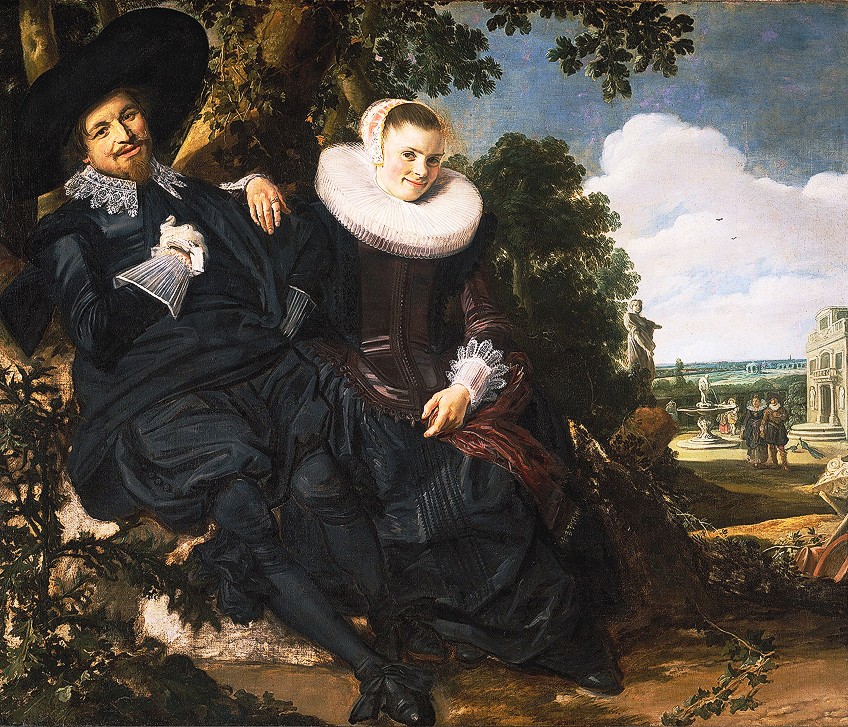
The two sitters are sprawled on a bench beneath a tree, their bodies and clothes dangling. Beatrix’s arm rests nonchalantly and proprietorially on her husband’s shoulder instead of politely, and they both smile pleasantly at the observer. This open body language, along with the sitters’ direct, pleasant gazes, lends the image a powerful sense of intimacy not found in other paintings of the time. The artwork is packed with love symbolism; aside from their close presence and ease, Isaac’s action of placing his right palm on his heart indicates his dedication to their new union.
An eryngium thistle grows to the left of the couple, a Dutch symbol for masculine faithfulness, while the ivy on the trees behind the couple represents eternity, commitment, and fertility. The backdrop picture, which depicts two lovers wandering through a garden of love, adds to the painting’s romantic significance. There are also two peacocks, which are frequently connected with heaven and forever.
While landscape backgrounds were not uncommon in 17th-century portraiture, the couple’s posture so near to nature is a departure from the more common settings of formal interiors or simple backgrounds.
Yonker Ramp and His Sweetheart (1623)
| Date Completed | 1623 |
| Medium | Oil on Canvas |
| Dimensions | 105 cm x 79 cm |
| Current Location | The Metropolitan Museum of Art, New York |
This piece depicts a young gentleman and lady at a pub. He raises a glass flask into the air and smiles, his lips wide, as a dog lays its head in his left palm. The woman is resting on the shoulders of the young man, she is smiling and staring at the camera. A half-opened curtain behind them exposes another chamber. This is Hals’s sole surviving piece that has a date indication on the canvas.
The work was given its current name in the 18th century, with Yonker signifying “youthful gentleman.” The lady, on the other hand, is more likely to be a prostitute than his sweetheart.
In this picture, Hals depicts his figures drinking, smiling, and with rosy cheeks and noses, outside of the conventional norms of comportment. The painting’s content has been the topic of much dispute among art historians, with some claiming that it conveys a moral message about the dangers of excess, which was not uncommon in genre paintings of the time.

Wilhelm von Bode was the first to clearly identify it with the biblical account of the Prodigal Son in 1909, and while modern viewers may have noticed the similarity of the wasting Old Testament character in the young man, there is little proof to support this interpretation. Irrespective of the painting’s intended intention, the scene provides an insight into 17th-century Haarlem life. Unlike many modern paintings that depict idealized portraits of sitters, this picture looks to contain a more authentic portrayal of individuals of the period. The style of depicting commonplace, everyday occurrences became an essential component of 19th-century painting, as seen in the paintings of Manet and Degas, among others, who showed scenes of nameless individuals in bars and cafés.
Dutch artist Frans Hals lived and worked in Haarlem, specializing in solo and group portraits as well as genre paintings. Hals was a key figure in the development of 17th-century group portraiture. His free impressionistic brushwork is well-known. He was a Baroque artist who used a radically open method to achieve intimate realism.
Frequently Asked Questions
Who Was Frans Hals?
Frans Hals’ ideas saw a resurgence in the 19th century, with his paintings inspiring both the subject and artistic approach of the Impressionists. Many of Frans Hals’ paintings include a smile, ranging from a little grin to a broad grin, which was unusual at a time when sitters were typically depicted with their lips closed and a serious expression. Hals’ figures are livelier and more human than those of many of his colleagues, and he captured laughter well.
What Was Unique About Frans Hals’ Paintings?
In contrast to the strict and formal attitudes prevalent elsewhere, Hals flipped compositional conventions by depicting people in a variety of situations. This was especially apparent in Frans Hals’ group portraits, in which he avoided boring monotony by grouping the individuals rather than placing them at equal intervals, including different gestures, and changing the sitters’ look direction. Frans Hals’ brushstrokes were visible and vibrant, giving his work a rough-textured appearance.
Isabella studied at the University of Cape Town in South Africa and graduated with a Bachelor of Arts majoring in English Literature & Language and Psychology. Throughout her undergraduate years, she took Art History as an additional subject and absolutely loved it. Building on from her art history knowledge that began in high school, art has always been a particular area of fascination for her. From learning about artworks previously unknown to her, or sharpening her existing understanding of specific works, the ability to continue learning within this interesting sphere excites her greatly.
Her focal points of interest in art history encompass profiling specific artists and art movements, as it is these areas where she is able to really dig deep into the rich narrative of the art world. Additionally, she particularly enjoys exploring the different artistic styles of the 20th century, as well as the important impact that female artists have had on the development of art history.
Learn more about Isabella Meyer and the Art in Context Team.
Cite this Article
Isabella, Meyer, “Frans Hals – Discover the Life and Artworks of This Dutch Painter.” Art in Context. May 23, 2022. URL: https://artincontext.org/frans-hals/
Meyer, I. (2022, 23 May). Frans Hals – Discover the Life and Artworks of This Dutch Painter. Art in Context. https://artincontext.org/frans-hals/
Meyer, Isabella. “Frans Hals – Discover the Life and Artworks of This Dutch Painter.” Art in Context, May 23, 2022. https://artincontext.org/frans-hals/.


